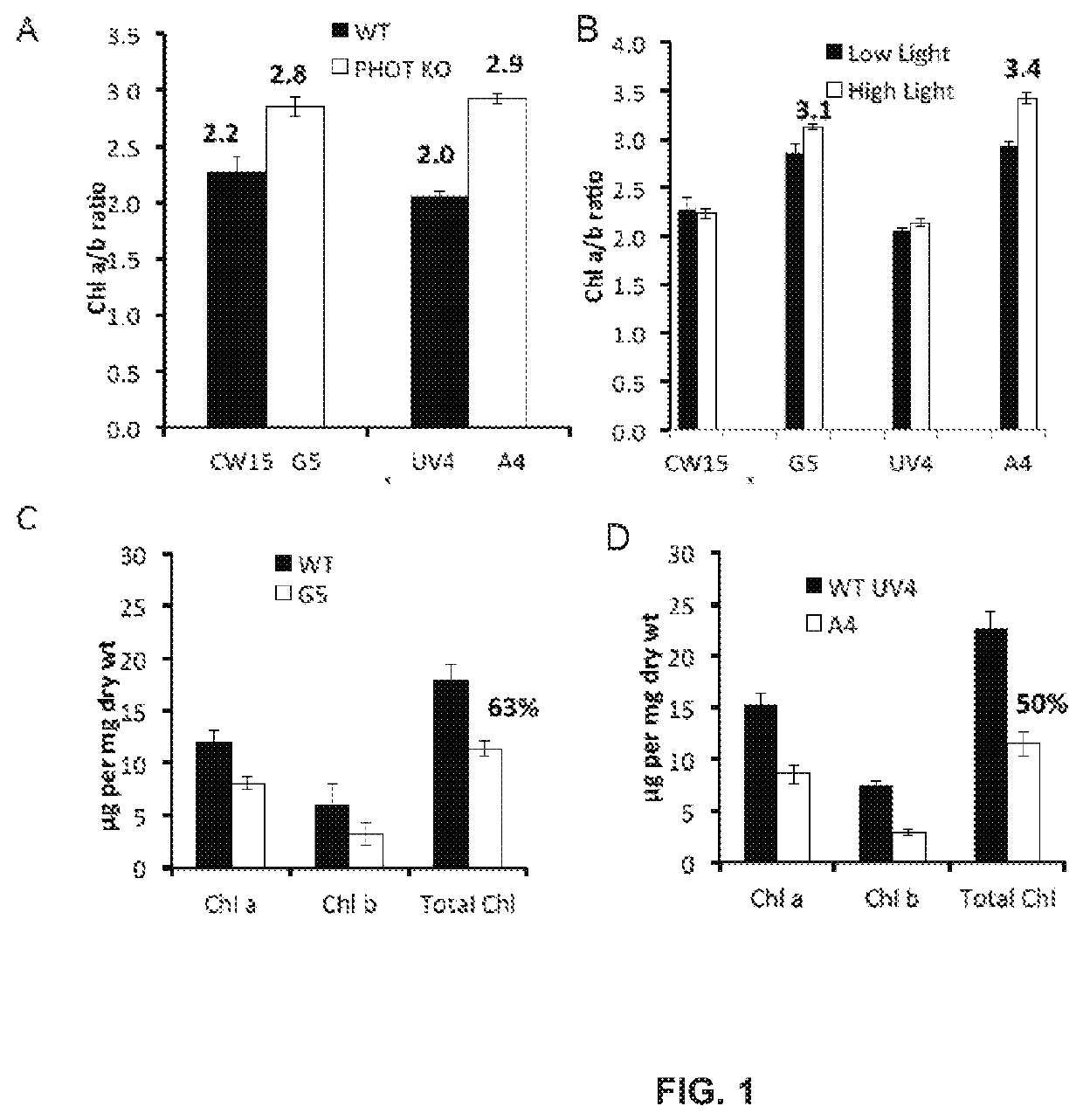Productivity and bioproduct formation in phototropin knock/out mutants in microalgae
a technology of phototropin and mutants, which is applied in the field of microalgae performance improvement, can solve the problems of no cell cycle implications of phototropin knockout or knockdown, etc., to achieve the effect of reducing phot expression, reducing the number of phot mutations, and improving the genetic stability of algal cell culture lines
- Summary
- Abstract
- Description
- Claims
- Application Information
AI Technical Summary
Benefits of technology
Problems solved by technology
Method used
Image
Examples
example 2
nt of Photoautotrophic Growth and Biomass Estimation
[0158]Photoautotrophic growth of the parent strains CW15 and UV4) and the phototropin knock out mutants (G5 and A4) was measured in environmental photobioreactors (“ePBRs”) (obtained from Phenometrics, Inc.) in 500 mL of liquid HS media. All experiments were done in triplicates for each time point and each treatment. Light intensity was programmed for a 12 h sinusoidal light period with a peak mid-day intensity of 2,000 μmol photons m−2 s−1. Temperature was a constant 25° C., and the ePBRs were stirred with a magnetic stir bar at 200 rpm. Filtered air was bubbled constantly through the growing cultures. The optical density of the cultures was monitored on a daily basis at 750 nm using a Cary 300 Bio UV-Vis spectrophotometer (Agilent). After completion of growth measurements, the total contents of individual ePBRs were harvested by centrifugation at 11,000 rpm for 15 min. Cell pellets were frozen immediately in liquid N2 and later f...
example 3
nt of Chlorophyll Fluorescence
[0159]For Chl fluorescence induction analysis, cell suspensions of the parental wild-type and transgenic Chlamydomonas strains were adjusted to a Chl concentration of ˜2.5 μg / mL. Quenching of Chl fluorescence was measured using the FL-3500 fluorometer (Photon System Instruments) (Kaftan, Meszaros et al. 1999). The cells were dark adapted for 10 min prior to the measurement. Chl fluorescence was induced using non-saturating continuous illumination and Chl fluorescence levels were measured every 1 μs using a weak pulse-modulated measuring flash. For the state transition experiments, low light grown cultures were dark adapted or pre-illuminated with 715 nm light for 10 min prior to the induction of Chl fluorescence. The actinic flash duration for this experiment was set to 50 μs and Chl fluorescence was measured every 1 μs.
example 4
nt of Photosynthetic Oxygen Evolution
[0160]CO2-supported rates of oxygen evolution were determined for low light (50 μmol photons m−2 s−1) HS grown log-phase cultures (0.4-0.6 OD750 nm) using a Clark-type oxygen electrode (Hansatech Instruments). Cells were re-suspended in 20 mM HEPES buffer (pH 7.4) and air-saturated rates of oxygen evolution were measured as a function of light intensity (650 nm) at 50, 150, 300, 450, 600, 750 and 850 μmol photons m−2 s−1. The same experiment was repeated in the presence of 10 mM NaHCO3. Light saturation curves were normalized on the basis of Chl as well as cell density (A750 nm). Chl was determined by method described by Arnon (Arnon 1949).
PUM
| Property | Measurement | Unit |
|---|---|---|
| concentration | aaaaa | aaaaa |
| pH | aaaaa | aaaaa |
| flow rate | aaaaa | aaaaa |
Abstract
Description
Claims
Application Information
 Login to View More
Login to View More - R&D
- Intellectual Property
- Life Sciences
- Materials
- Tech Scout
- Unparalleled Data Quality
- Higher Quality Content
- 60% Fewer Hallucinations
Browse by: Latest US Patents, China's latest patents, Technical Efficacy Thesaurus, Application Domain, Technology Topic, Popular Technical Reports.
© 2025 PatSnap. All rights reserved.Legal|Privacy policy|Modern Slavery Act Transparency Statement|Sitemap|About US| Contact US: help@patsnap.com



